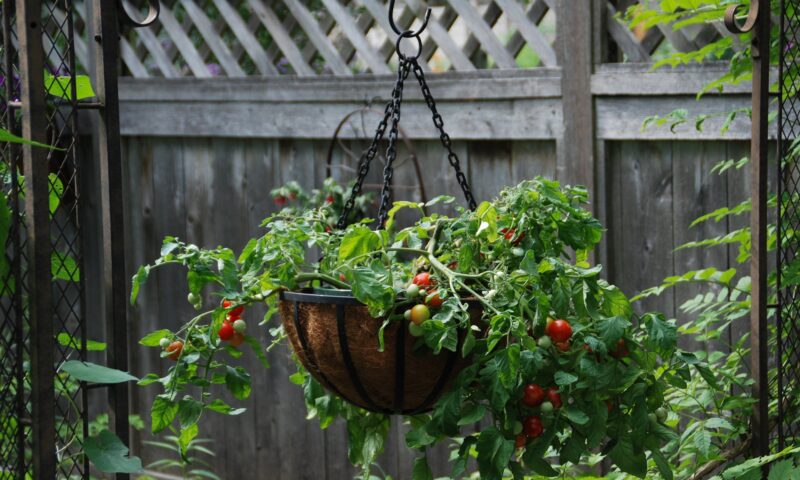(Pictured: If gardening space is limited, grow tomatoes in hanging baskets or containers.)
By Melinda Myers
Nothing beats the flavor of fresh-from-the-garden tomatoes. Keep them close at hand by growing one or more in containers on your patio, balcony, or front steps.
Any tomato can be grown in a pot, but determinate varieties are shorter and more compact, making them a bit easier to manage in a container. They produce fruit in a relatively short time, making them great or preserving as well as using fresh. Look for a D or determinate on the plant tag, seed packet, or in the catalog description.
Indeterminate tomatoes, often designated with an I, are usually much taller and continue to grow, flower, and produce fruit until frost kills the plant or you pinch out the growing tip. These are usually staked or grown in wire cages to save space, reduce pest problems, and make harvesting easier. Many new containers have built-in trellises, or creative gardeners craft their own, making it easier and more attractive to grow these bigger plants in pots.
Semi-determinate varieties are in between these two. They are compact like determinates, often trailing, but produce fruit throughout the growing season like indeterminate varieties.
You can find compact varieties often sold as miniature and dwarf plants that grow well in 4-inch to 8-inch pots. They are a great option for those with limited space, gardening on balconies, indoors in a sunny window or just about anywhere. Kitchen Mini tomatoes, Heartbreakers, Red Velvet, and Micro Tom Thumb are just a few.
The growing process
Grow one tomato per container for maximum productivity. Use a 5-gallon or bigger container for large varieties and at least a two to three gallon or similar size pot for smaller varieties. Some research suggests a pot that is at least 14 inches but preferably 20 inches wide will yield greater results. Adding flowers and herbs to the container boosts the beauty and diversity of your container garden but will reduce the number of tomatoes produced.
Growing tomatoes in containers also allows you to start the season earlier. Just move the planter inside when the weather is harsh and back outside when the weather is warm and sunny. As the weather turns cold at the end of the growing season, cover the planter or move it into a frost-free location as needed. Some gardeners even move a pot or two inside to finish off the tomato season.
Plant tomatoes in a container with drainage holes and fill it with a quality potting mix. Reduce the time spent watering with a self-watering pot that has a reservoir to hold water and extend the time between watering. Further reduce the need to water by adding an organic, sustainable soil amendment like certified organic Wild Valley Farms’ wool pellets (wildvalleyfarms.com) to the potting mix. Made from wool waste, this product reduces watering by up to 25 percent.
Water thoroughly when the top few inches begin to dry. Mulch the soil with evergreen needles, shredded leaves, or other organic mulch to keep the soil consistently moist and suppress weeds. Consistent soil moisture encourages more flowering and fruiting, while reducing the risk of blossom end rot, cracking, and misshapen fruit.
Harvest tomatoes when fully colored or leave them on the plant a few more days for an even sweeter flavor. You’ll enjoy their use in salads, sauces, and other favorite recipes.
Melinda Myers (melindmyers.com) is the author of more than 20 gardening books, host of the “How to Grow Anything” instant video and DVD series. and a columnist and contributing editor for Birds & Blooms magazine.
